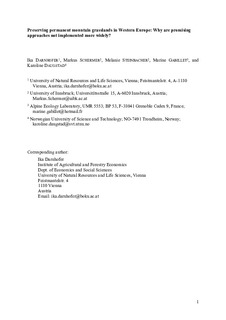| dc.contributor.author | Darnhofer, Ika | |
| dc.contributor.author | Schermer, Markus | |
| dc.contributor.author | Steinbacher, Melanie | |
| dc.contributor.author | Gabillet, Marine | |
| dc.contributor.author | Daugstad, Karoline | |
| dc.date.accessioned | 2017-11-08T13:53:18Z | |
| dc.date.available | 2017-11-08T13:53:18Z | |
| dc.date.created | 2017-08-14T12:51:54Z | |
| dc.date.issued | 2017 | |
| dc.identifier.citation | Land Use Policy. 2017, 68 306-315. | nb_NO |
| dc.identifier.issn | 0264-8377 | |
| dc.identifier.uri | http://hdl.handle.net/11250/2464994 | |
| dc.description.abstract | To protect grasslands and maintain the ecosystem services they provide, many European countries have been offering agri-environment measures aimed at maintaining extensive grazing by cattle, sheep or goats. Yet, despite more than two decades of agri-environment measures, semi-natural mountain pastures are still seen as threatened by abandonment and subsequent shrub encroachment. Building on a three-round Delphi inquiry, we analyse the perception of a range of experts on how measures aimed at maintaining mountain grasslands are designed and implemented in Austria, France and Norway. Results show that the experts see the need for a stronger involvement of diverse regional actors, the need to increase the flexibility given to farmers in managing mountain grasslands, and the need to reconceptualise monitoring as a social learning process. While these approaches are implemented in some ‘best practice’ examples, they are not widespread. Understanding these approaches as requiring double-loop learning may contribute to explaining their limited spread. Indeed, they build on a radically different conceptualization of farmers and of researchers, and thus of how agri-environment measures need to be designed and implemented to be effective. Yet, such radical changes are likely to be resisted. | nb_NO |
| dc.language.iso | eng | nb_NO |
| dc.publisher | Elsevier | nb_NO |
| dc.rights | Attribution-NonCommercial-NoDerivatives 4.0 Internasjonal | * |
| dc.rights.uri | http://creativecommons.org/licenses/by-nc-nd/4.0/deed.no | * |
| dc.title | Preserving permanent mountain grasslands in Western Europe: Why are promising approaches not implemented more widely? | nb_NO |
| dc.type | Journal article | nb_NO |
| dc.type | Peer reviewed | nb_NO |
| dc.description.version | acceptedVersion | nb_NO |
| dc.source.pagenumber | 306-315 | nb_NO |
| dc.source.volume | 68 | nb_NO |
| dc.source.journal | Land Use Policy | nb_NO |
| dc.identifier.doi | 10.1016/j.landusepol.2017.08.005 | |
| dc.identifier.cristin | 1486107 | |
| dc.relation.project | Norges forskningsråd: 225463 | nb_NO |
| dc.description.localcode | © 2017. This is the authors’ accepted and refereed manuscript to the article. LOCKED until 12.8.2020 due to copyright restrictions. This manuscript version is made available under the CC-BY-NC-ND 4.0 license http://creativecommons.org/licenses/by-nc-nd/4.0/ | nb_NO |
| cristin.unitcode | 194,67,10,0 | |
| cristin.unitname | Geografisk institutt | |
| cristin.ispublished | true | |
| cristin.fulltext | postprint | |
| cristin.qualitycode | 1 | |

